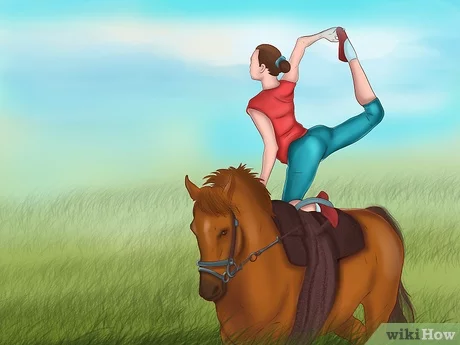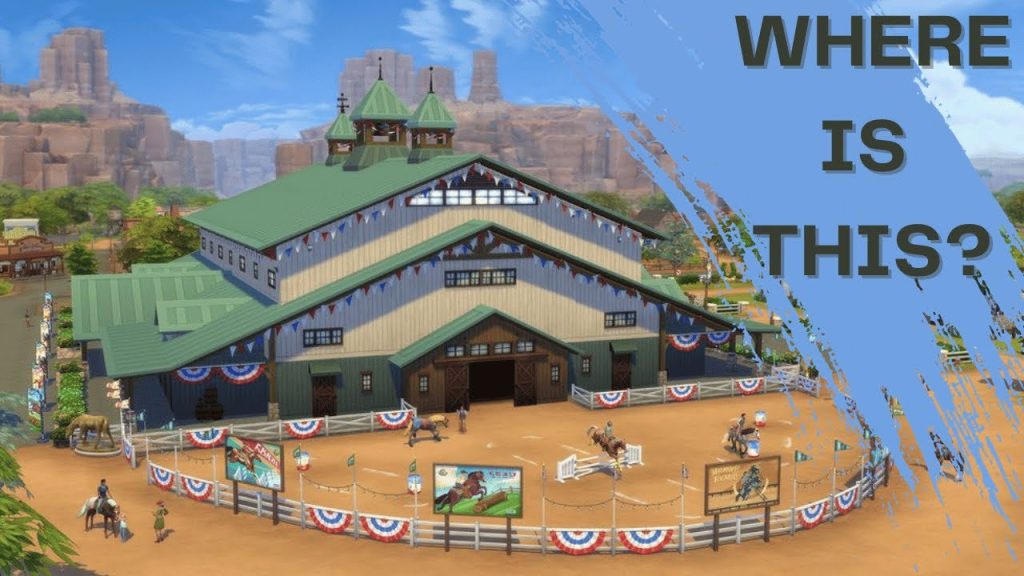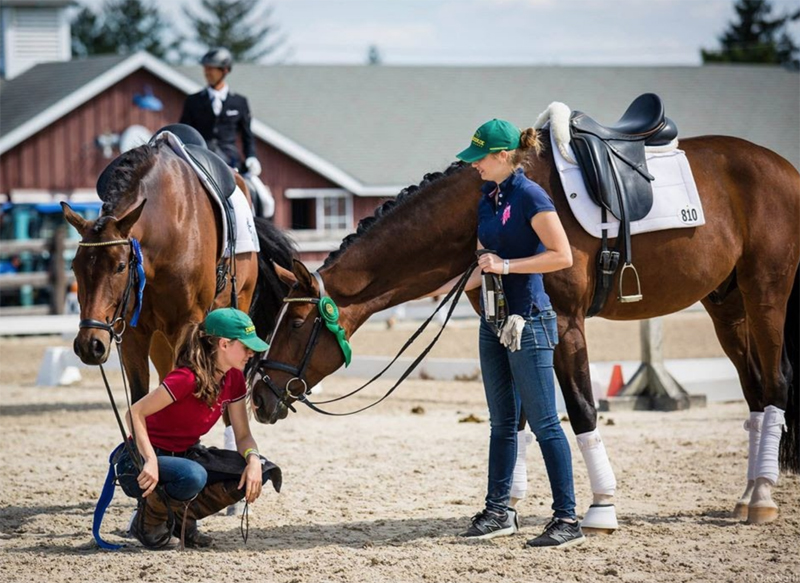Becoming an equestrian is an exciting journey. It involves learning about horses and riding skills.
For many, the dream of becoming an equestrian starts in childhood. Horses are majestic animals, and riding them can be a thrilling experience. But being an equestrian is more than just riding. It involves understanding horse behavior, proper grooming, and stable management.
Whether you are a beginner or looking to improve your skills, this guide will help you navigate the essentials. From selecting the right gear to building a bond with your horse, you’ll find practical advice and tips. Join us as we explore the steps to becoming a confident and skilled equestrian. Dive in and start your equestrian journey today!

Credit: www.tiktok.com
Introduction To Equestrianism
Equestrianism is the art of riding, handling, and training horses. It is a popular activity that has captured hearts for centuries. This sport offers many benefits, including physical fitness, mental relaxation, and a strong bond with the horse. If you are interested in learning about equestrianism, this guide will introduce you to its history and various activities.
History Of Equestrianism
The history of equestrianism dates back thousands of years. Horses were first domesticated around 4000 BC. Early humans used them for transport and farming. Over time, riding horses became a skill and a symbol of status. Kings and warriors rode horses into battles. They showed their power and speed. In ancient Greece, horse riding became a sport. The Greeks included chariot races in the Olympic Games. By the Middle Ages, knights rode horses in jousting tournaments. The Renaissance saw the rise of dressage. This is the art of training horses to perform precise movements. Equestrianism continued to evolve, leading to modern competitive events.
Types Of Equestrian Activities
There are many types of equestrian activities. Each has its unique appeal. Here are some popular types:
- Dressage: This is the art of training horses to perform precise movements. It requires harmony between horse and rider. The goal is to show grace and control.
- Show Jumping: Riders guide their horses over a series of obstacles. The aim is to jump cleanly and quickly. It tests the horse’s agility and the rider’s skill.
- Eventing: This is a combination of dressage, cross-country, and show jumping. It is also called the “equestrian triathlon”. It tests all-around skills.
- Endurance Riding: Riders cover long distances over varied terrain. It tests stamina and navigation skills. The welfare of the horse is crucial.
- Polo: This is a team sport played on horseback. Riders use mallets to hit a ball into the opposing team’s goal. It requires speed, strategy, and teamwork.
Each type offers different experiences and challenges. Choose the one that interests you most. Whether you seek elegance, speed, or endurance, there is an equestrian activity for you.
Choosing The Right Horse
Choosing the right horse is a crucial step for every aspiring equestrian. It’s important to find a horse that matches your riding skills, personality, and goals. This process involves understanding different horse breeds and selecting a horse that suits your needs.
Horse Breeds
Horse breeds vary greatly in size, temperament, and suitability for different activities. Some popular breeds for beginners include Quarter Horses, Arabian Horses, and Thoroughbreds. Each breed has unique characteristics that may appeal to different riders. For example, Quarter Horses are known for their calm nature, making them great for beginners.
Selecting A Suitable Horse
Selecting a suitable horse involves evaluating your own riding skills and goals. Beginners should seek a horse with a gentle temperament. It’s also important to consider the horse’s age and training level. A well-trained, older horse is often a better choice for new riders. Always seek advice from experienced equestrians or trainers when choosing a horse.
Essential Riding Gear
Being an equestrian requires not just skill and passion but also the right gear. The proper equipment ensures safety, comfort, and style while riding. This section explores the essential riding gear you need to make the most of your equestrian journey.
Riding Apparel
Appropriate riding apparel is crucial for comfort and performance. Here’s a breakdown:
- Riding Pants: Known as breeches or jodhpurs, these are tight-fitting and stretchy to allow for flexibility.
- Riding Shirt: Choose a breathable and moisture-wicking shirt to stay cool and dry.
- Riding Boots: Tall boots provide ankle support and grip. Paddock boots are shorter but also effective.
- Gloves: Protects your hands from blisters and provides a better grip on the reins.
Safety Equipment
Safety should always be a priority when riding. Essential safety equipment includes:
- Helmet: A certified riding helmet protects your head in case of falls. Ensure it fits snugly.
- Body Protector: Worn under your shirt, it shields your torso from impacts.
- Reflective Gear: If you ride in low light, reflective vests or bands make you visible to others.
Having the right gear enhances your riding experience. Invest in quality equipment for both safety and comfort.

Credit: www.youtube.com
Basic Riding Techniques
Learning the basic riding techniques is the cornerstone of becoming a skilled equestrian. These techniques ensure you communicate effectively with your horse and ride safely. Let’s dive into the essentials of mounting and dismounting and the fundamental riding commands every beginner should know.
Mounting And Dismounting
Mounting and dismounting properly is crucial for both your safety and your horse’s comfort. Follow these steps:
| Step | Action |
|---|---|
| 1 | Hold the reins in your left hand and the saddle with your right. |
| 2 | Place your left foot in the stirrup. |
| 3 | Push up and swing your right leg over the horse. |
| 4 | Gently lower yourself into the saddle. |
| 5 | Ensure both feet are in the stirrups. |
For dismounting, follow these steps:
- Remove your feet from the stirrups.
- Lean forward slightly and swing your right leg over the horse.
- Gently lower yourself to the ground.
Basic Riding Commands
Understanding and using basic riding commands helps you guide your horse. Here are some essential commands:
- Walk: Gently squeeze with your legs to signal the horse to move forward.
- Trot: Apply a bit more pressure with your legs and give a slight nudge.
- Canter: Apply even more pressure and use a verbal cue, like “canter”.
- Stop: Pull back gently on the reins while saying “whoa”.
- Turn: Pull the rein in the direction you want to go while applying pressure with the opposite leg.
Practicing these commands regularly will help you build a strong bond with your horse. Consistent practice also improves your confidence in the saddle.
Caring For Your Horse
Taking care of a horse is a big responsibility. Proper care ensures your horse stays healthy and happy. This involves a consistent routine, the right diet, and regular check-ups. Let’s explore what you need to do daily to keep your horse in top condition.
Daily Care Routine
A daily care routine is essential for your horse’s well-being. Here are the steps to follow:
- Grooming: Brush your horse to remove dirt and debris. This keeps their coat clean and shiny. It also helps you check for any injuries or skin issues.
- Hoof Care: Pick out your horse’s hooves daily. Look for stones, dirt, or signs of infection. Healthy hooves are crucial for your horse’s mobility.
- Exercise: Ensure your horse gets regular exercise. This can include riding, lunging, or free-running in a safe area.
- Hydration: Always provide fresh water. Horses need to stay hydrated to avoid colic and other health issues.
- Check for Injuries: Inspect your horse for cuts, swelling, or other signs of injury. Early detection helps prevent serious problems.
Feeding And Nutrition
Proper feeding and nutrition are vital for your horse’s health. Here are some key points to consider:
| Feed Type | Description |
|---|---|
| Forage | Hay or grass should make up the majority of your horse’s diet. It provides essential fiber. |
| Grains | Grains like oats, barley, and corn are energy sources. Feed in moderation to avoid weight gain. |
| Supplements | Consider adding vitamins and minerals to balance the diet. Consult a vet for recommendations. |
Feeding tips:
- Regular Schedule: Feed your horse at the same times each day. Consistency helps with digestion.
- Measure Portions: Avoid overfeeding by measuring portions. Adjust based on your horse’s activity level and weight.
- Clean Feeding Area: Keep the feeding area clean to prevent contamination and illness.
Incorporate these practices to ensure your horse gets the best care possible.
Training And Lessons
Becoming a skilled equestrian requires dedication to training and lessons. The right guidance and consistent practice are key. This section will help you understand the importance of finding a good trainer and provide tips for effective practice.
Finding A Trainer
A good trainer can make a big difference. Look for someone experienced and patient. Check their certifications and reviews. Visit their facility. Observe a lesson. Ensure the trainer’s teaching style fits your learning style. A good rapport is essential. A supportive environment boosts confidence and progress.
Practice Tips
Regular practice is crucial. Set a schedule and stick to it. Focus on different skills each session. Warm up your horse before starting. Use a mix of exercises to keep it interesting. Pay attention to your posture. Correct technique prevents injuries. Reward your horse for good behavior. This encourages cooperation. Keep a journal of your progress. Reflect on what works and what needs improvement.
Health And Safety
Riding horses is thrilling but requires attention to health and safety. Ensuring your well-being and the horse’s well-being is crucial. This section will guide you through common health issues and preventive measures.
Common Health Issues
Equestrians face several health issues. Back pain is a common problem due to long hours of riding. Joint pain in knees and hips can also occur. Muscle strains are frequent, especially in the legs and core. Skin conditions like sunburn and chafing happen often. Awareness of these issues helps in taking timely action.
Preventive Measures
Regular stretching is essential to prevent muscle strains. Warm-up exercises help prepare your body for riding. Wearing proper riding gear reduces the risk of injuries. A well-fitted helmet is crucial for head protection. Gloves protect your hands and improve grip. Use sunscreen to prevent sunburn. Hydration is key. Drink water before and after riding.
Regular check-ups with a doctor ensure early detection of issues. Consulting a physiotherapist can help manage pain and improve flexibility. Invest in good quality riding boots to protect your feet and ankles. Proper horse care is also important. Regular vet check-ups keep your horse healthy. A healthy horse means a safer ride.
Joining The Equestrian Community
Joining the equestrian community is an exciting journey. It offers a chance to connect with others who share your passion for horses. This community is welcoming and supportive. You will find like-minded individuals ready to help and guide you.
Equestrian Clubs
Equestrian clubs are a great starting point. They provide structured environments for learning. You can meet experienced riders who can mentor you. Clubs often offer lessons, training sessions, and social events. These activities help you improve your skills and make new friends.
Participating In Events
Participating in events is another way to immerse yourself. Local shows, competitions, and fairs are perfect for this. They allow you to showcase your skills and learn from others. Events also offer networking opportunities. You can meet trainers, breeders, and other enthusiasts. This helps you build valuable connections in the community.
Advanced Equestrian Skills
Becoming an advanced equestrian takes dedication and skill. It involves mastering techniques that go beyond basic riding. In this section, we will cover two key areas: Jumping Techniques and Dressage Basics.
Jumping Techniques
Jumping is an exciting part of equestrian sports. It requires a combination of balance, timing, and coordination. Here are some important techniques to master:
- Approach: Maintain a steady pace and keep your horse calm.
- Take-Off: Ensure your horse pushes off with power and accuracy.
- In the Air: Keep your body in sync with the horse’s movement.
- Landing: Absorb the impact and prepare for the next obstacle.
Practicing these steps will help you and your horse jump more confidently.
Dressage Basics
Dressage is the art of training a horse to perform precise movements. It emphasizes harmony between horse and rider. Here are some basics:
- Posture: Sit tall and balanced in the saddle.
- Aids: Use gentle cues to communicate with your horse.
- Transitions: Smoothly change gaits and speeds.
- Patterns: Practice specific movements like circles and serpentines.
Regular practice of these basics will improve your dressage skills significantly.

Credit: www.wikihow.pet
Frequently Asked Questions
What Is The First Step To Becoming An Equestrian?
The first step is to take riding lessons from a certified instructor. This ensures you learn proper techniques and safety.
How Much Does Equestrian Training Cost?
Equestrian training costs vary widely. On average, lessons can range from $40 to $100 per hour.
What Gear Do I Need To Start Riding?
Basic gear includes a helmet, riding boots, and comfortable clothing. Safety and comfort are essential.
How Often Should I Practice Riding?
Practicing at least once or twice a week is recommended. Consistency helps improve skills and confidence.
Conclusion
Becoming an equestrian is a rewarding journey. Start with basic riding lessons. Practice consistently. Build a strong bond with your horse. Learn about horse care and equipment. Stay patient and committed. Enjoy every ride and progress. Equestrian skills improve over time.
Keep learning and growing. Happy riding!



